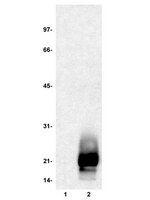Discovery of potent small molecule inhibitors of DYRK1A by structure-based virtual screening and bioassay.
Di Wang,Fei Wang,Yexiong Tan,Liwei Dong,Lei Chen,Weiliang Zhu,Hongyang Wang
Bioorganic & medicinal chemistry letters
22
2011
Zobrazit abstrakt
In this study, six novel dual-specificity tyrosine phosphorylation regulated kinase 1A (DYRK1A) inhibitors with IC(50) values ranging from 1.51 to 88.13 ?M were successfully identified through virtual screening and in vitro plus cell based bioassay. Compound 5 with IC(50) value of 1.51 ?M is the most potent hit against DYRK1A in vitro, while compound 3 exhibited the most potent activity in cultured cells. The inhibition mechanism was explored by molecular docking approach. This study may provide a start point for further mechanism based study as well as discovery of drug candidate against Down syndrome (DS). | | 22154664
 |
Structural and functional characterization of recombinant human cellular retinaldehyde-binding protein.
J W Crabb,A Carlson,Y Chen,S Goldflam,R Intres,K A West,J D Hulmes,J T Kapron,L A Luck,J Horwitz,D Bok
Protein science : a publication of the Protein Society
7
1998
Zobrazit abstrakt
Cellular retinaldehyde-binding protein (CRALBP) is abundant in the retinal pigment epithelium (RPE) and Müller cells of the retina where it is thought to function in retinoid metabolism and visual pigment regeneration. The protein carries 11-cis-retinal and/or 11-cis-retinol as endogenous ligands in the RPE and retina and mutations in human CRALBP that destroy retinoid binding functionality have been linked to autosomal recessive retinitis pigmentosa. CRALBP is also present in brain without endogenous retinoids, suggesting other ligands and physiological roles exist for the protein. Human recombinant cellular retinaldehyde-binding protein (rCRALBP) has been over expressed as non-fusion and fusion proteins in Escherichia coli from pET3a and pET19b vectors, respectively. The recombinant proteins typically constitute 15-20% of the soluble bacterial lysate protein and after purification, yield about 3-8 mg per liter of bacterial culture. Liquid chromatography electrospray mass spectrometry, amino acid analysis, and Edman degradation were used to demonstrate that rCRALBP exhibits the correct primary structure and mass. Circular dichroism, retinoid HPLC, UV-visible absorption spectroscopy, and solution state 19F-NMR were used to characterize the secondary structure and retinoid binding properties of rCRALBP. Human rCRALBP appears virtually identical to bovine retinal CRALBP in terms of secondary structure, thermal stability, and stereoselective retinoid-binding properties. Ligand-dependent conformational changes appear to influence a newly detected difference in the bathochromic shift exhibited by bovine and human CRALBP when complexed with 9-cis-retinal. These recombinant preparations provide valid models for human CRALBP structure-function studies. Celý text článku | | 9541407
 |
Cyclic AMP decreases the phosphorylation state of myelin basic proteins in rat brain cell cultures.
Ulmer, J B, et al.
J. Biol. Chem., 262: 1748-55 (1987)
1987
Zobrazit abstrakt
Previous work has suggested that myelin basic proteins are phosphorylated prior to their appearance in the myelin sheath (Ulmer, J. B. and Braun, P. E. (1984) Dev. Neurosci. 6, 345-355). In order to corroborate this finding we have examined the phosphorylation of myelin basic proteins in rat brain cell cultures containing 14-17% oligodendrocytes. Incorporation of 32P into the 14-, 17-, 18.5-, and 21.5-kDa myelin basic proteins was observed in cells incubated with 32P at 7, 14, and 21 days in culture. Myelin basic proteins in 14-day cells incorporated 32P linearly until at least 120 min after the addition of isotope. The apparent half-life of myelin basic protein phosphate groups was determined to be approximately 80 min in pulse-chase experiments. However, this value may be an overestimation due to the presence of significant levels of acid-soluble radioactivity in the cells throughout the chase period. The presence of dibutyryl cAMP or 8-bromo-cAMP in the incubation medium substantially inhibited the incorporation of 32P into the myelin basic proteins at all time points studied. The presence of dibutyryl cAMP in the chase medium in pulse-chase experiments resulted in an increase in the turnover rate of [32P] phosphate in the myelin basic proteins. These results indicate that cAMP decreases the phosphorylation state of myelin basic proteins in oligodendrocytes by inhibiting the phosphorylation and/or stimulating the dephosphorylation of myelin basic proteins. | | 2433287
 |
Identification of multiple in vivo phosphorylation sites in rabbit myelin basic protein.
Martenson, R E, et al.
J. Biol. Chem., 258: 930-7 (1983)
1982
Zobrazit abstrakt
Myelin basic protein of rabbit brain (Mr = 18,200) was initially freed of the bulk of the nonphosphorylated species (mainly component 1) by Cm-cellulose chromatography at high pH. The remainder of the protein was subjected to peptic digestion at pH 6.00, which resulted in specific, essentially complete cleavage at several bonds (Phe-44--Phe-45, Phe-87--Phe-88, Leu-109--Ser-110, and Leu-151--Phe-152) and partial cleavage at the Tyr-14--Leu-15 bond. Gel filtration of the digest through Sephadex G-25 (fine) yielded three fractions, the first containing primarily peptides 1-44 and 45-87, the second peptides 15-44, 88-109, and 110-151, and the third peptides 1-14 and 152-168. Each fraction was chromatographed on Cm-cellulose at pH 8.2, and the resulting subfractions and partially purified peptides were analyzed for phosphoserine and phosphothreonine. Materials containing significant amounts of the phosphoamino acids were subsequently chromatographed on Cm-cellulose at pH 4.65, and the analyses for phosphoserine and phosphothreonine were repeated. The resulting purified peptic phosphopeptides were identified by amino acid analysis and tryptic peptide mapping. Comparison of the maps with those of the unphosphorylated counterparts located the tryptic phosphopeptides. These were recovered and their identities were established by amino acid analysis. In those cases where the phosphopeptide contained 2 Ser residues, the position of the phosphoserine was established by aminopeptidase M digestion. Five phosphorylation sites were found: Ser-7, Ser-56, Thr-96, Ser-113, and Ser-163. Only a small fraction of these sites was phosphorylated in the total basic protein, with values ranging from about 2 (ser-113) to 6% (Thr-96). With the possible exception of Ser-56, these sites are not the ones that have been reported to be phosphorylated in vitro by cyclic AMP-dependent protein kinase. | | 6185481
 |


















